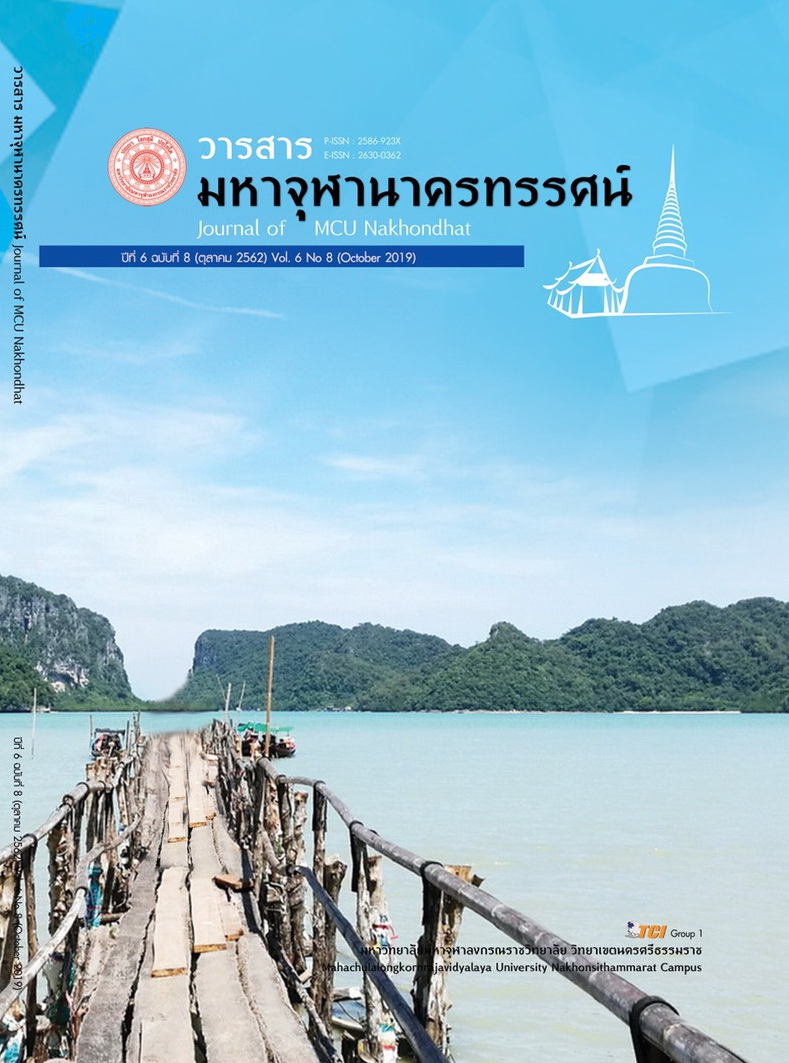BUDDHIST PSYCHOLOGY FACTORS GENERATING COGNITIVE PROCESSES IN BUDDHIST ART
Main Article Content
Abstract
The subject of this research is the factors caused to the cognitive processes and wisdom as the concept of Buddhist psychology passed through Buddhist artworks. This is a Qualitative Research. The objectives of this research were to study Buddhist artworks that reflect the Buddhist principles, and psychology about cognition and wisdom. secondly, to study the cognitive processes and wisdom as the concept of Buddhist psychology, and the last one was to present that factors that cause to the cognitive processes and wisdom as the concept of Buddhist psychology passed through Buddhist artworks.
Result of the research:
1) the Buddhist artworks that reflect the principles, and psychology about cognition and wisdom by creation passed thinking process as concept of aesthetics, semiotics, and Buddhist principles 2) the cognitive processes and wisdom as concept of Buddhist psychology to integrate with cognitive psychology of Gestalt ‘s Theory, and 3) The factors have caused the cognitive processes and wisdom as concept of Buddhist psychology passed through Buddhist artworks is communication that leads to the cognitive processes and wisdom between the narrator, and Buddhist artworks by using Buddhist artworks transmitted knowledge consist of symbolic communication and knowledge of Buddhist principles. The narrator has used the Buddhist principles to motivate the teaching of principles to Buddhist that leads to the cognitive processes and wisdom as the concept of Buddhist psychology.
Article Details
References
ชยาภรณ์ สุขประเสริฐ. (2554). ศึกษาวิเคราะห์จิตรกรรมในการเผยแผ่พุทธธรรมในพระพุทธศาสนา กรณีพระมหาธาตุเจดีย์ภักดีประกาศ วัดทางสาย จังหวัดประจวบคีรีขันธ์. ใน วิทยานิพนธ์พุทธศาสตรดุษฎีบัณฑิต สาขาวิชาพระพุทธศาสนา. มหาวิทยาลัยมหาจุฬาลงกรณราชวิทยาลัย.
ณรงค์ คุ้มกลัด. (2545). พระพุทธศาสนากับทฤษฎีสัญลักษณ์: ศึกษาเปรียบเทียบความเข้าใจในการใช้สัญลักษณ์ ของพุทธศาสนิกชนไทย ในเขตบางซื่อ กรุงเทพมหานคร. ใน วิทยานิพนธ์ศิลปศาสตรมหาบัณฑิต สาขาศาสนาเปรียบเทียบ. มหาวิทยาลัยมหิดล.
พระครูธรรมธรนิเทศ อภิญาโณ. (2559). บทบาทของวัดในการเสริมสร้างให้เกิดสันติสุขในชุมชน. วารสารสันติศึกษาปริทรรศน์, 4(2), 82-90.
พระไพศาล วิสาโล. (2558). การเสริมสร้างพลังทางศีลธรรมในสังคมไทย. เรียกใช้เมื่อ 4 สิงหาคม 2562 จาก https://www.visalo.org/article/budKarnsermsang.htm
พระไพศาล วิสาโล. (2558). ศิลปะกับพุทธศาสนา. เรียกใช้เมื่อ 14 สิงหาคม 2562 จาก https://www.visalo.org/article/PosttoDay255308.html
พระมหาอุดม ปญฺญาโภ. (2556). การศึกษาวิเคราะห์พุทธศิลป์เชิงสุนทรียศาสตร์: ศึกษากรณีเฉพาะพระพุทธรูปสมัยอยุธยา. ใน วิทยานิพนธ์พุทธศาสตรมหาบัณฑิต สาขาวิชาพระพุทธศาสนา. มหาวิทยาลัยมหาจุฬาลงกรณราชวิทยาลัย.
สงวน บุญรอด. (2526). พุทธศิลป์รัตนโกสินทร์. กรุงเทพมหานคร: โรงพิมพ์รุ่งวัฒนา.
เสถียร โพธินันทะ. (2543). ประวัติศาสตร์พระพุทธศาสนา. (พิมพ์ครั้งที่ 4). นครปฐม: โรงพิพม์มหามงกุฎราชวิทยาลัย.


